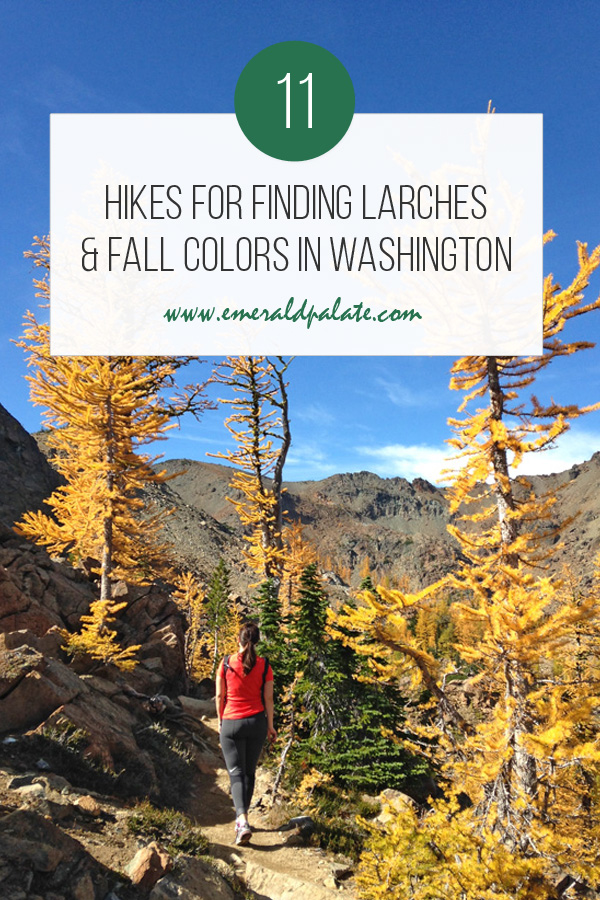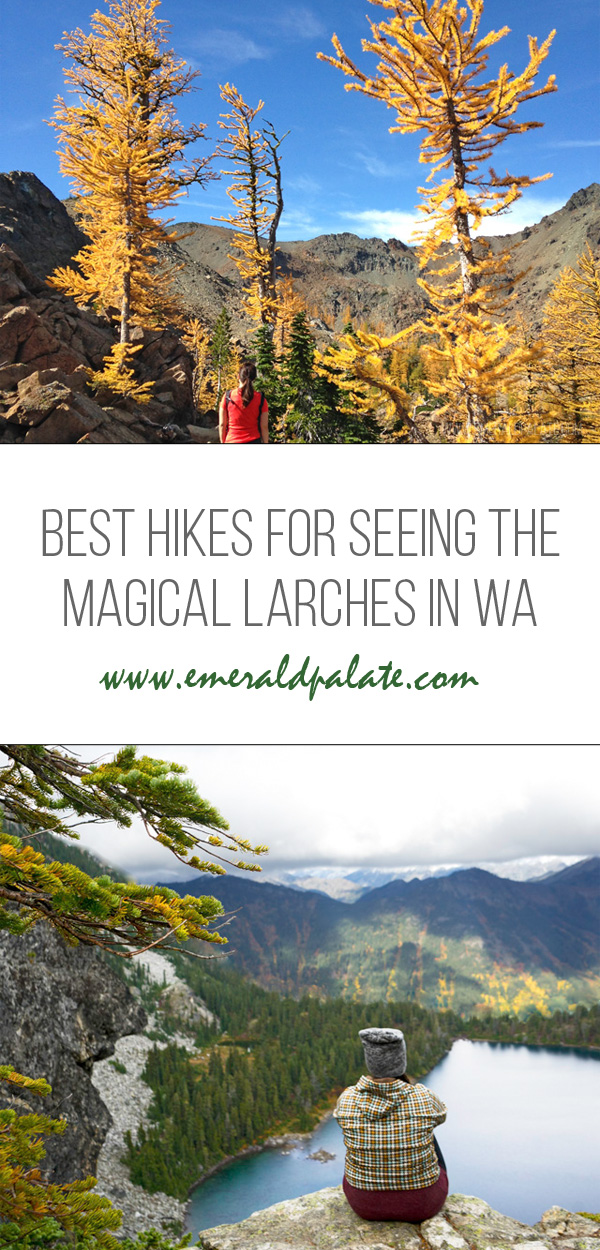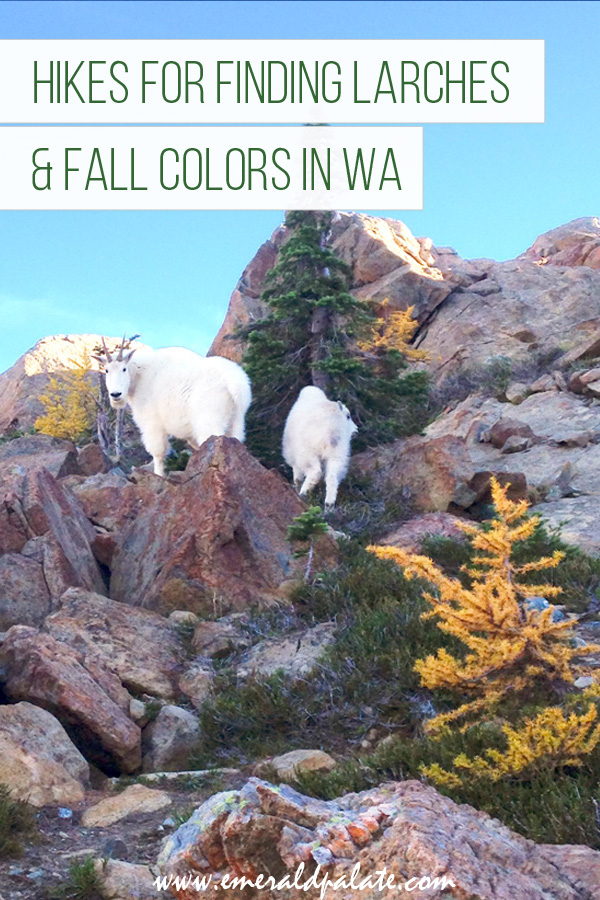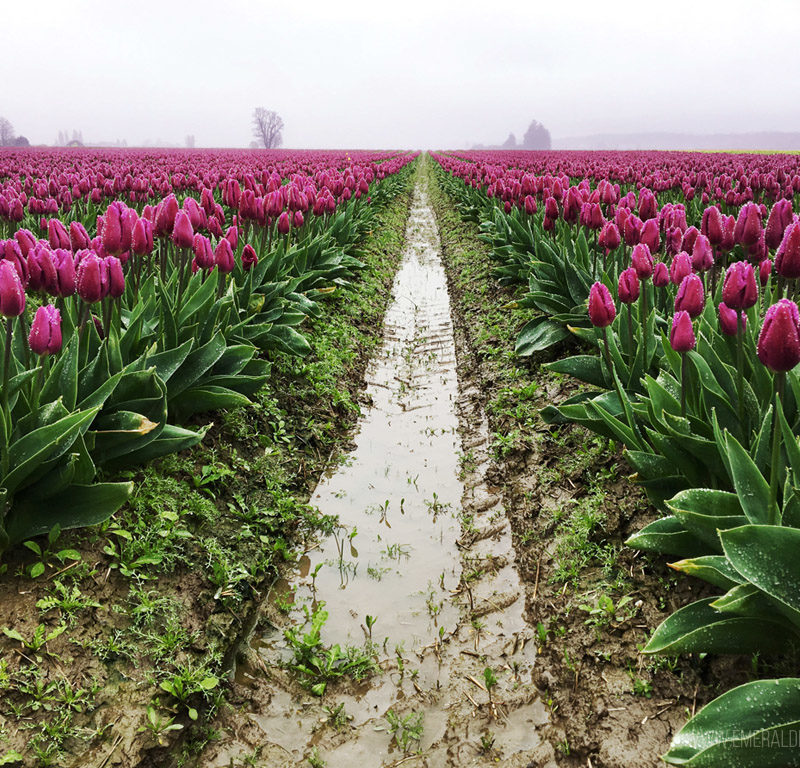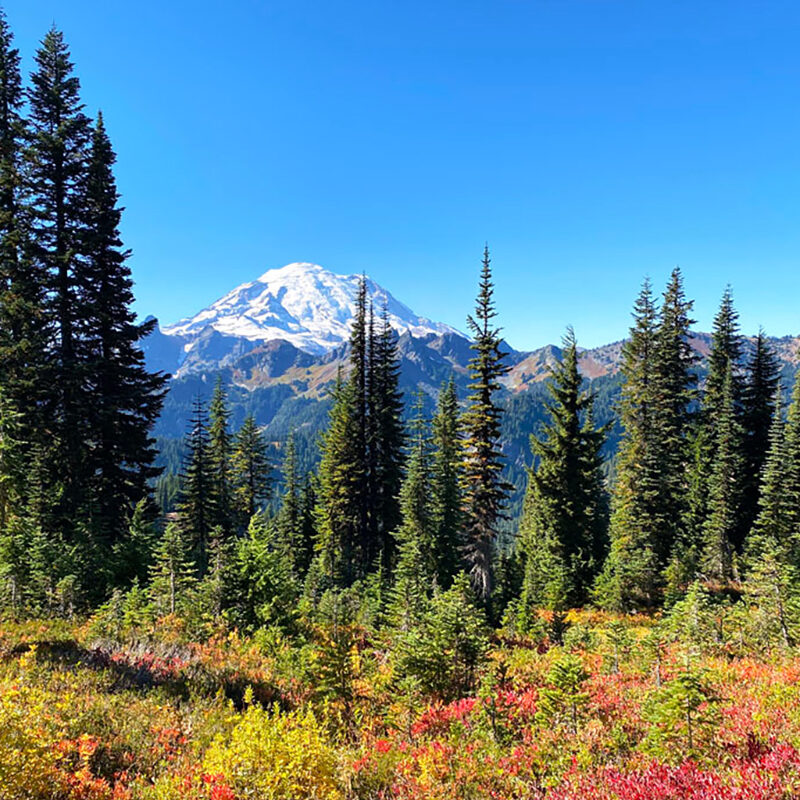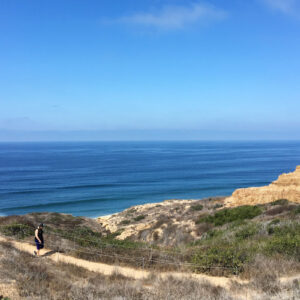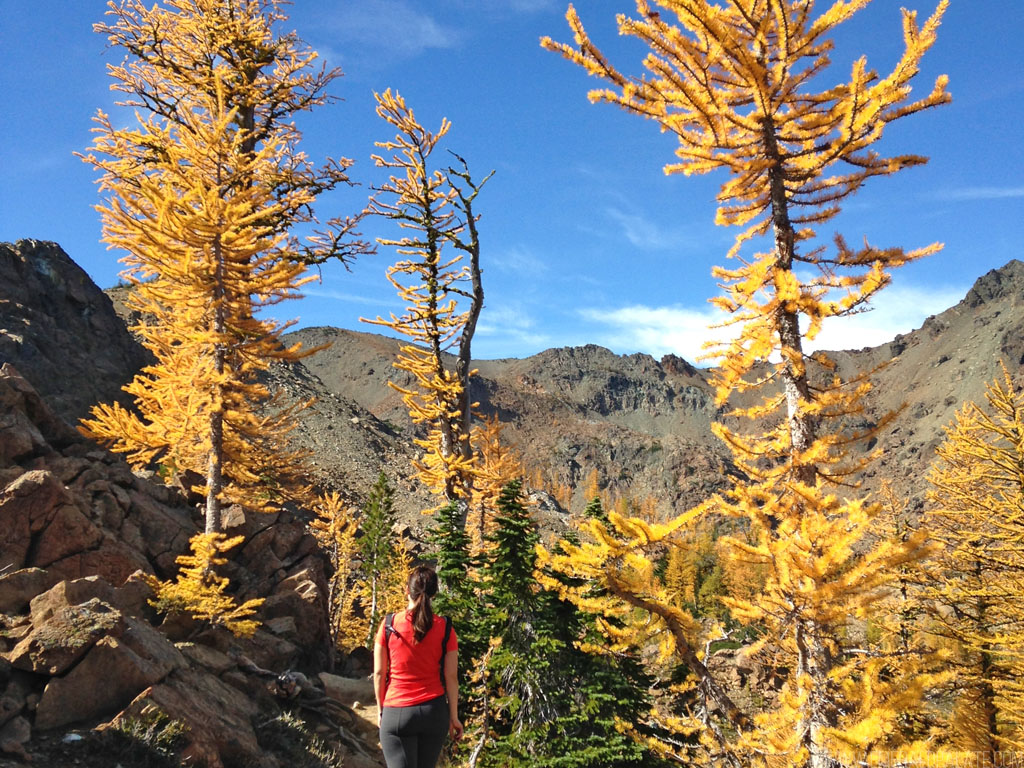
I discovered the best larch hikes in Washington via an in-flight magazine when I moved to Seattle from the east coast. It was a multi-page story with jaw-dropping photos of alpine lakes dotted with something I’d never seen before: golden pine trees. I immediately researched to find out more about these magical specimens.
I discovered that I moved to a special place. Washington is one of the few places in the world to find alpine larches, the name of these needle-bearing trees that turn gold in the fall. However, to find them you have to know their secrets.
In this post I outline all the best larch hikes in Washington I’ve found since living here. I also share tips on when to go and how to find these mysterious larches. Get ready for some of the most breathtaking fall foliage in Washington state!
This post has affiliate links, which means I’ll earn a small commission at no cost to you if you click on them and make a purchase. This is a small way I earn money to support this site. If links aren’t showing up for you, turn off your ad blocking software. Thank you for your support!
First, a larch lesson. Larches are conifer trees (a.k.a. they have needles instead of leaves) that turn gold in late September through October and then drop their leaves like traditional deciduous trees. When larches are at their peak, they make for breathtaking fall foliage in Washington state, particularly when alongside fiery reds and oranges from other colorful flora.
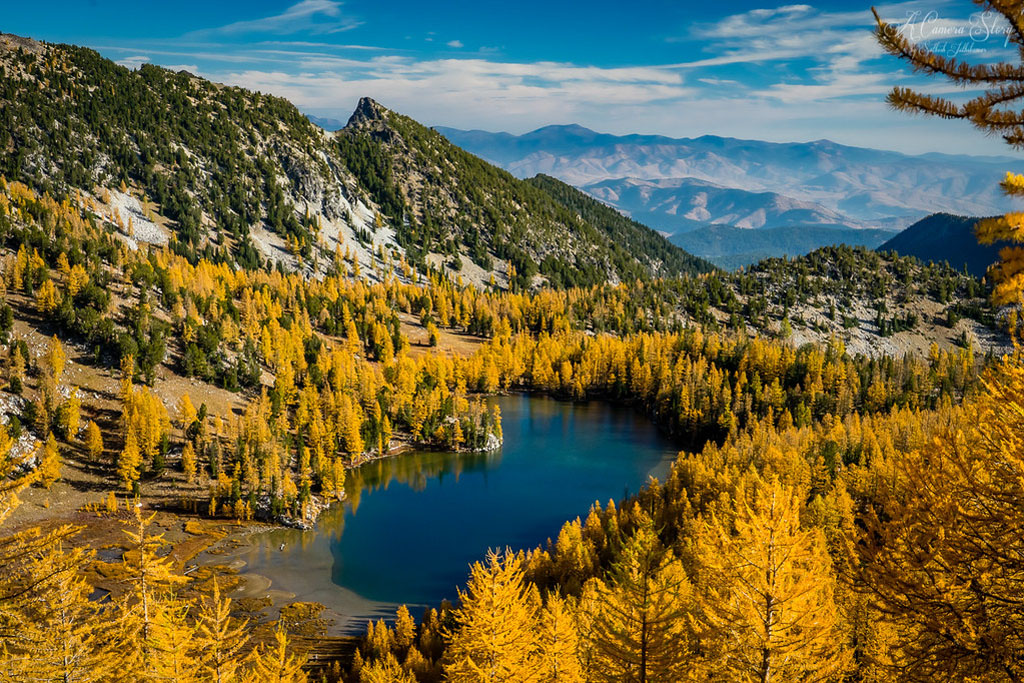
Photo via Sathish J
Larches are found in cold climates in the northern hemisphere. In North America we find them in Washington, Oregon, Idaho, Montana, British Columbia, and Alberta. The U.S. Forest Service explains that the reason larches change colors is because they’re saving up nutrients for the winter. The chemical process that happens in these trees is what causes the needles to turn gold for just a few weeks.
Best Larch Hikes in Washington
Larches are magical, but they can be tricky to find. Knowing which hikes have larches is one thing, but knowing when the larches are “ready” is another.
You see, the time of year larches change color varies. I’ve seen them change as early as mid-September and as late as Halloween. They only last 2-3 weeks before they drop their needles, so you have to be ready.
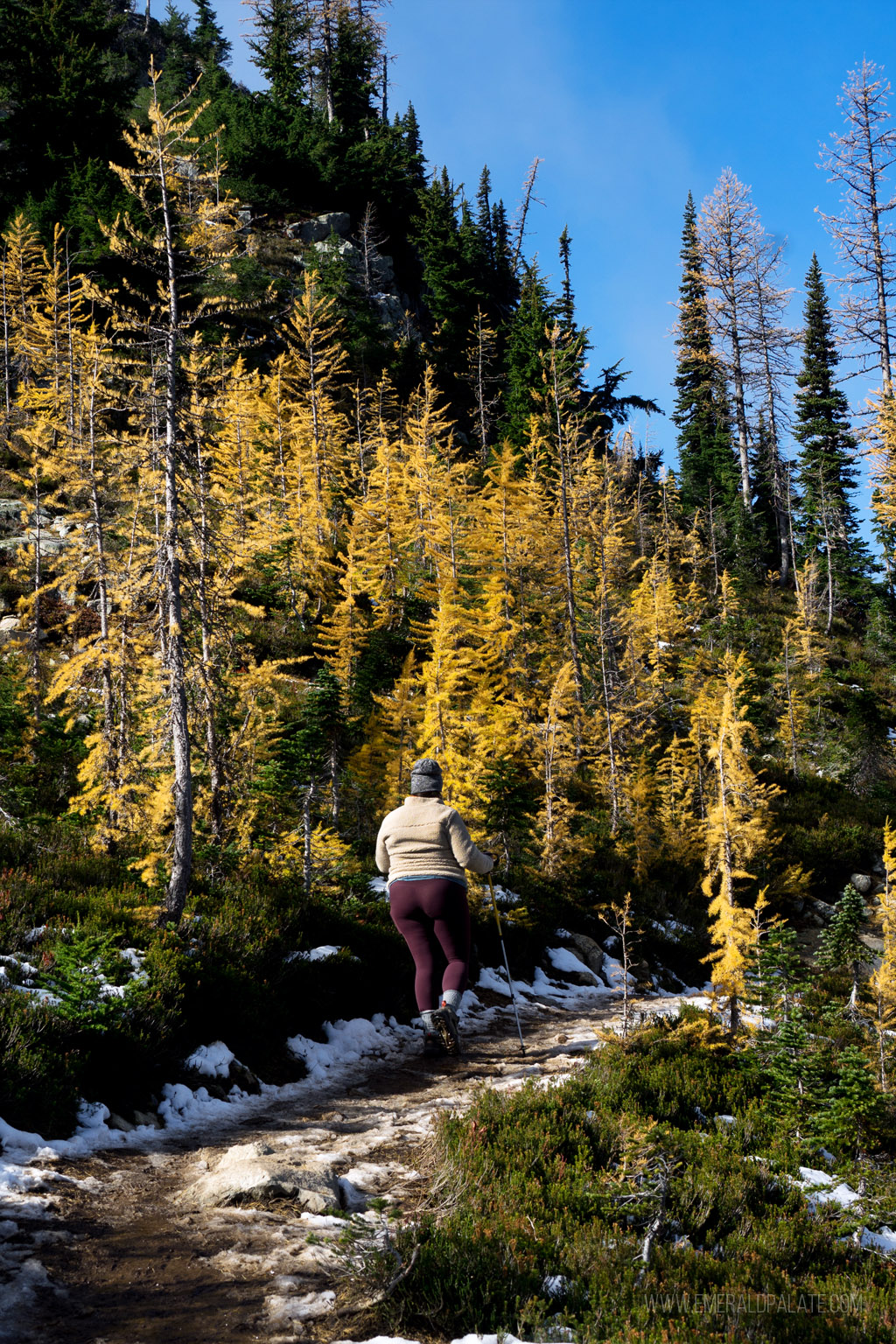
Here are my Tips for finding larch hikes
Search comments on the Washington Trail Association. Here’s my process:
- In September, open up the larch hikes listed below in separate tabs.
- For each hike, scroll to the trip reports at the bottom of the page and expand recent comments. Use “command + F” to search the page for “larch”.
- Once these trip reports start mentioning larches, pay attention. Hikers tend to use verbiage like, “They’re starting to turn,” or “They’re ready.” Use this info plus road conditions to narrow down which hike you do.
- If you want to see if other hikes not listed below have larches, use WTA’s advanced search to scour trip reports for the word “larch”.
Plan enough time for your trip
Lastly, remember larches grow in cold climates. In Washington, that means trails high up in the mountains.
I find it challenging to prioritize larch hikes in one day, since most take at least 3 hours to drive to from Seattle…each way. It’s doable, but the best option is to stay near the hike you want to take so you can get an early start the following day. This is especially important for larch hikes that have limited parking and get crowded.
Here are some articles for finding places to stay near the best larch hikes in Washington:
- Dreamy Cabins in Leavenworth
- Winthrop’s Best Cabins
- Unique Hotels in Washington
- Best Winter Cabins in Washington
- Romantic Airbnbs in Washington
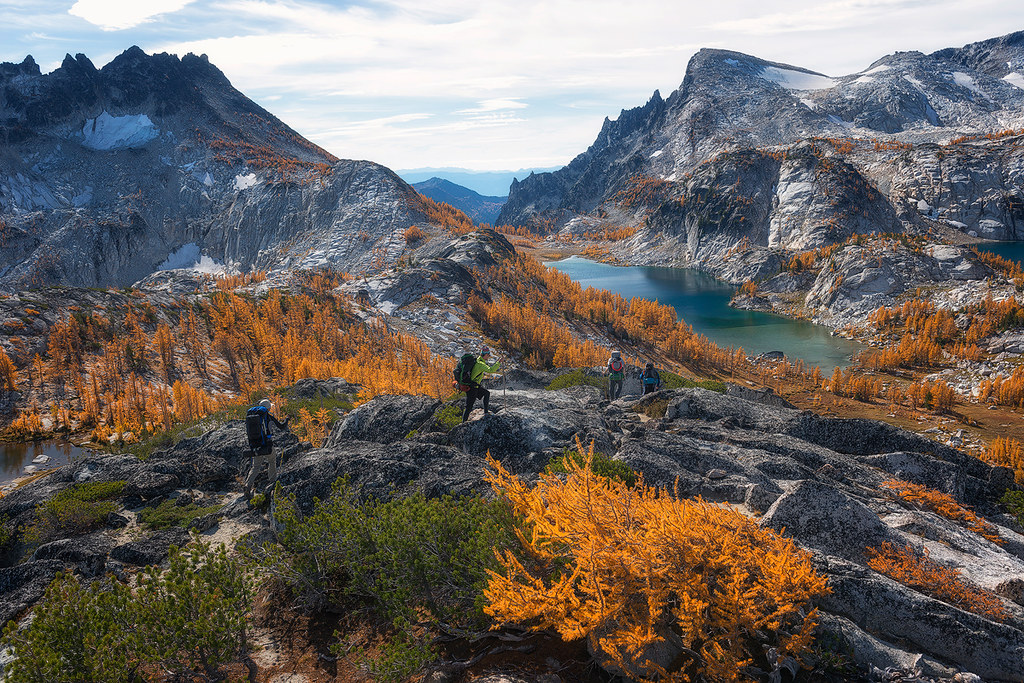
Photo via Paul Weeks
Ok, let’s dive into my favorite larch hikes for seeing fall foliage in Washington state. I separated them out by area, as they all over the state.
Don’t have time to plan a trip? Leave it to me. I can build you a custom travel itinerary so all you have to do is show up.
Snoqualmie-area hikes for larches
Snoqualmie is one of the closest areas to Seattle for seeing larches. However, since the elevation isn’t has high as in other areas, most people don’t talk about these hikes when referencing going on a larch march.
However, they’re working seeking out because they are the most western larches you’ll find in Washington!
Lake Ingalls
Alltrails link | wta.org link | ~9 miles | difficult | Northwest Forest Pass required
Lake Ingalls is about a 2 hour, 45-minute drive from Seattle. This was one of the first larch hikes I did and it’s still one of my favorite. When in full bloom the larches are a deep golden color, almost looking fake against a clear blue sky. There’s also a blue alpine lake at the summit and, if you’re lucky, curious mountain goats who will pause for a picture while they check you out.
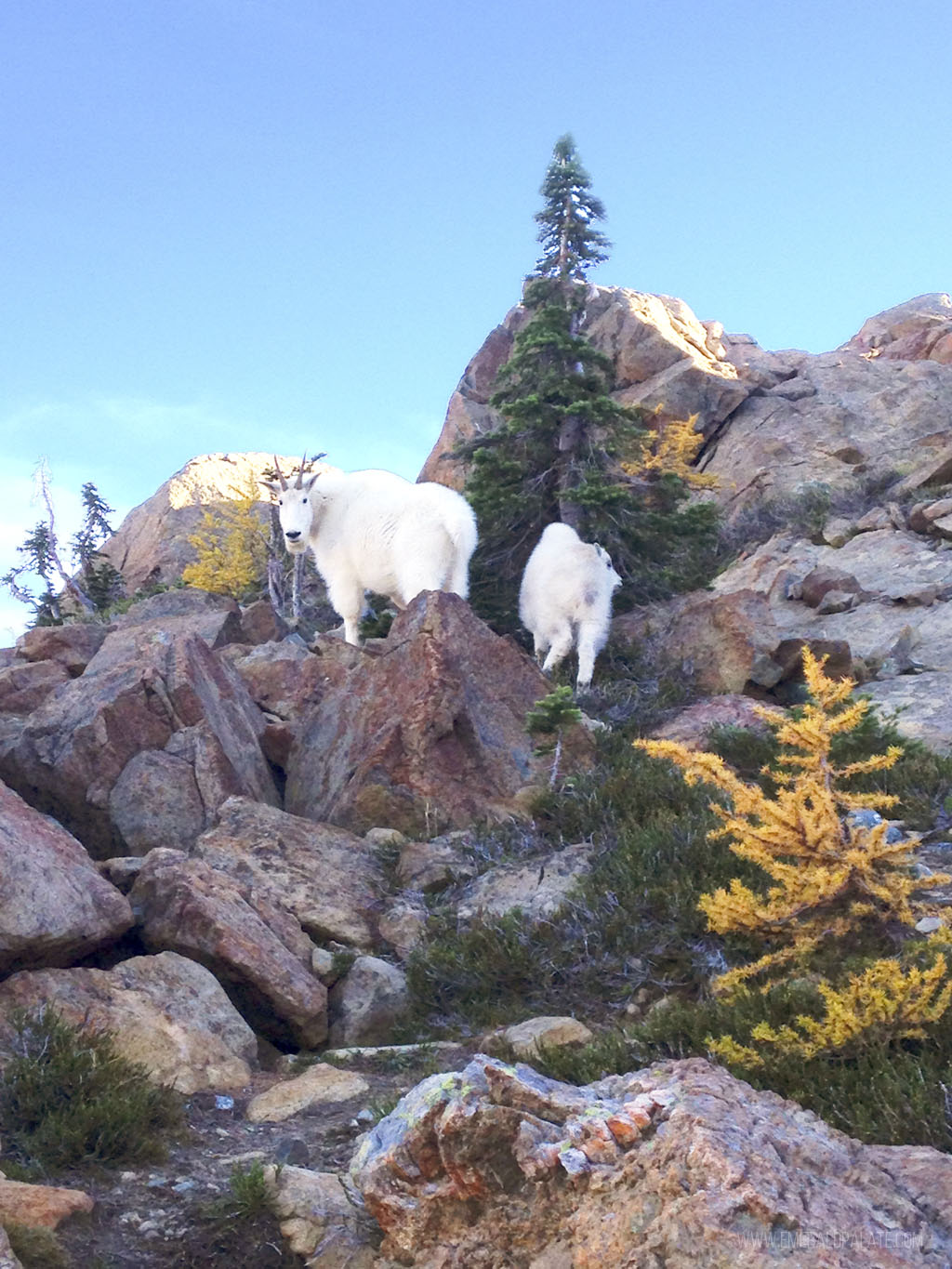
I remember finding this hike quite challenging. We lost the trail along a ridge at one point and found ourselves scrambling along boulders to climb up and find the trail. This caused me to go into muscle failure toward the last mile, leaving me limping all the way down.
The road to get to this hike is bumpy. We made it in my Honda Civic, but I was going about 1-mile an hour. A car with higher clearance would be better. It also gets really dark in the area. Don’t do what we did and finish the trail in pitch black only to have to drive the desolate bumpy road out.
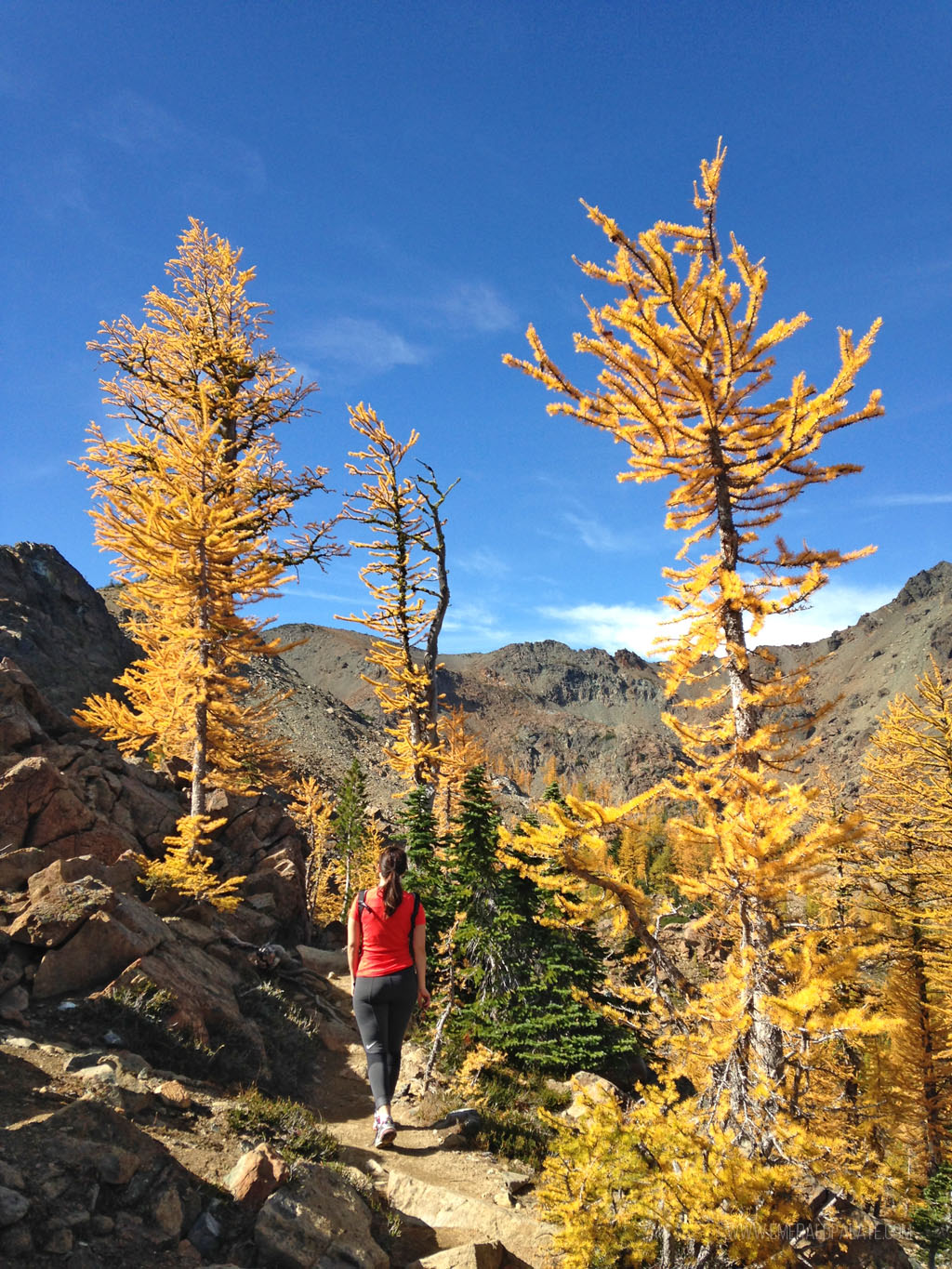
Esmerelda Basin to Lake Ann
Alltrails link | wta.org link | ~8.2 miles | moderate | Northwest Forest Pass required
Lake Ann is accessible via the Esmerelda Basin trailhead, which is about 2.5 hours from Seattle. People refer to it as the less-popular alternative to Lake Ingalls, as you can access Lake Ingalls from a trail connecting this one to it.
The Esmerelda Basin trail is popular in spring thanks to its meadows and seemingly endless amounts of wildflowers. During fall you’ll be in those switchback through those meadows, with not a larch in sight.
You may start wondering if this is actually a larch hike, but you’ll be rewarded if you take the the intersection to a pass overlooking Lake Ann. There you’ll find larches dotting the slopes around the lake, oftentimes in snow if larches are turning later in the season.
Leavenworth-area larch hikes
Here are the best larch hikes near Leavenworth, WA in the Central Cascades region. Leavenworth is about a 2 to 2.5 hour drive from Seattle and is located pretty much in the middle of Washington state. These Leavenworth hikes include larches and are the perfect driving distance for going leaf-peeping in Washington.
Since you’ll be in the area, check out my guide to the best restaurants in Leavenworth, Washington for dinner afterwards!
Tronsen Ridge
Alltrails link | wta.org link | ~8 miles | moderate | Northwest Forest Pass required
Tronsen Ridge is located in the Blewett Pass area, which is about a 2 hour, 40 minute drive from Seattle and an hour drive from Leavenworth. I haven’t been on this hike yet, but I have it on my list because it’s said to be a great larch hike. It’s also said to have beautiful wildflowers in the spring.
Carne Mountain
Alltrails link | wta.org link | ~7.3 miles | difficult | no pass required
Carne Mountain is located in the Steven’s Pass area, which is about a 2-hour drive from Seattle and a 30 min-drive from Leavenworth. I haven’t been on this hike yet, but it’s been on my list for a while because of photos I’ve seen with wall-to-wall golden larches. I hear this one is quite difficult, so make sure you’re prepared before embarking.
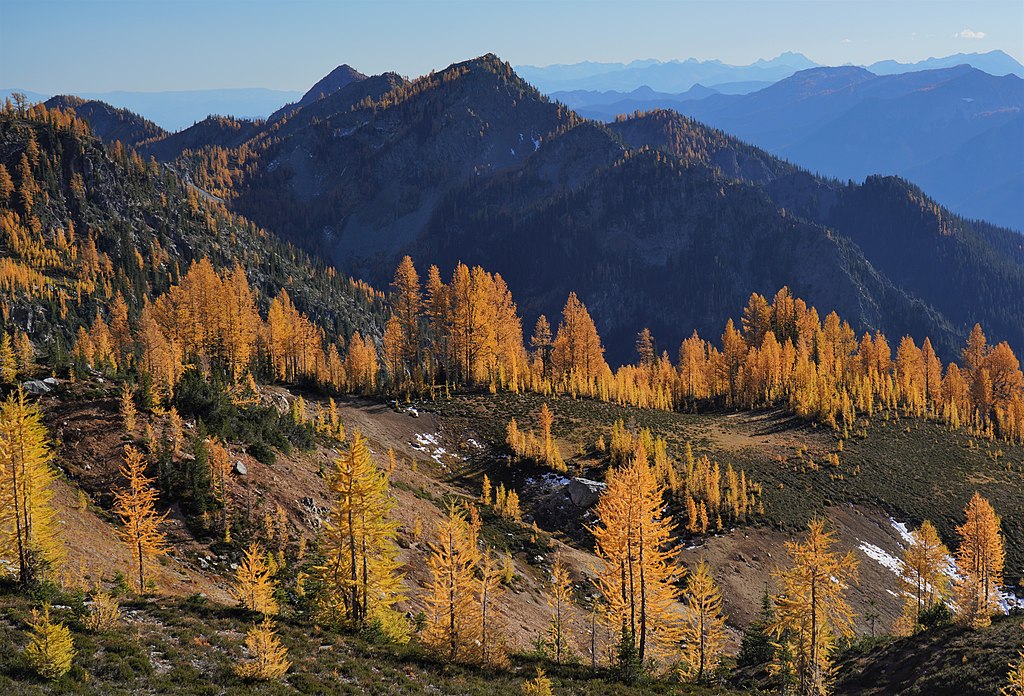
Photo via Martin Bravenboer
Colchuck Lake
Alltrails link | wta.org link | ~8 miles | difficult | Northwest Forest Pass required
Colchuck Lake is about a 3-hour drive from Seattle and a 30-minute drive from Leavenworth. This is arguably one of the most well-known of the best larch hikes in Washington because it’s connected to The Enchantments (more on this in a second).
Golden larches dot the blue lake at the summit, sometimes covered in snow, and provide a magical experience. However, I can’t emphasis enough that this is a rather challenging hike best suited for those who are athletic and/or regular hikers. All the influencers will tell you to do this hike, and it’s popular, but I was completely blindsided by how difficult it is. I honestly thought I wasn’t going to make it at certain points!
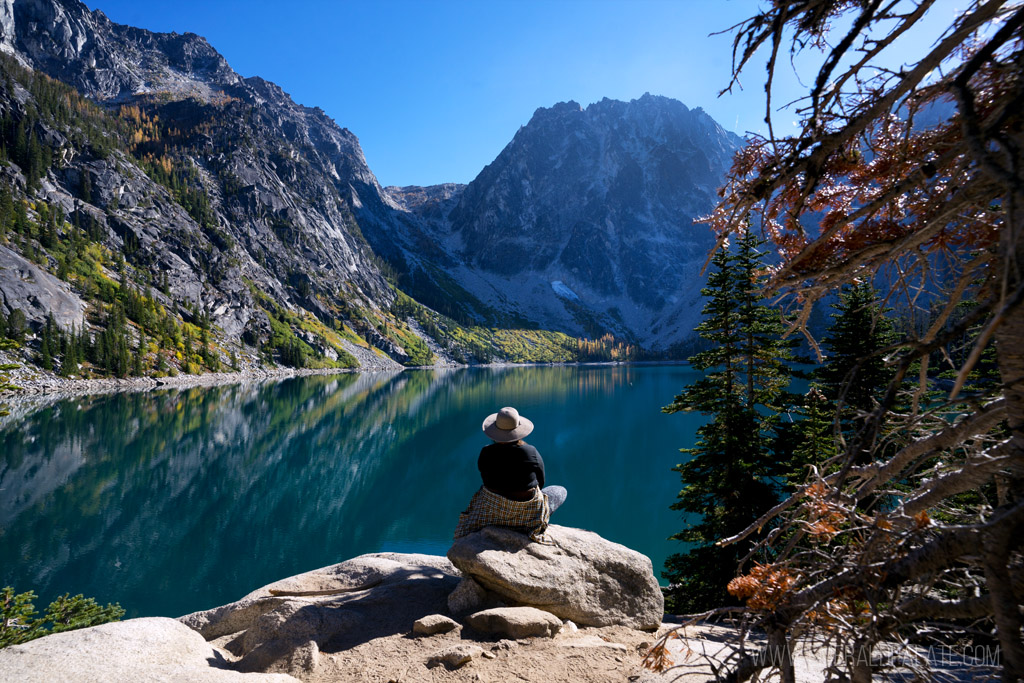
Let me break down why it took so long. First, I’m definitely sedentary these days. I only hike 1-2 times a year, but figured I could handle it because I used to be an athlete. My boyfriend is fitter and didn’t struggle as much, but he also thought this hike was hard.
Second, we had to restart the first 1/4 mile because of a bear. I heard my boyfriend say, “Yup there’s a bear,” and look up to see a baby bear on the path ahead. It followed us all the way back to the parking lot. Everyone was safe, but we had to start over.
Third, the metrics on this hike are misleading. Hiking calculators take the elevation gain and average it across the distance, so if you divide 2,280 ft in elevation over 8 miles, that’s about a 285-ft climb each mile. Climbing about 500-ft per mile is considered a hard hike, so the metrics make it seem like Colchuck is moderate.
However, the hike starts easy and goes up and down a bunch. So really, you’re mostly climbing the second half of the ascent. My boyfriend guessed it was more like ~800 ft a mile!
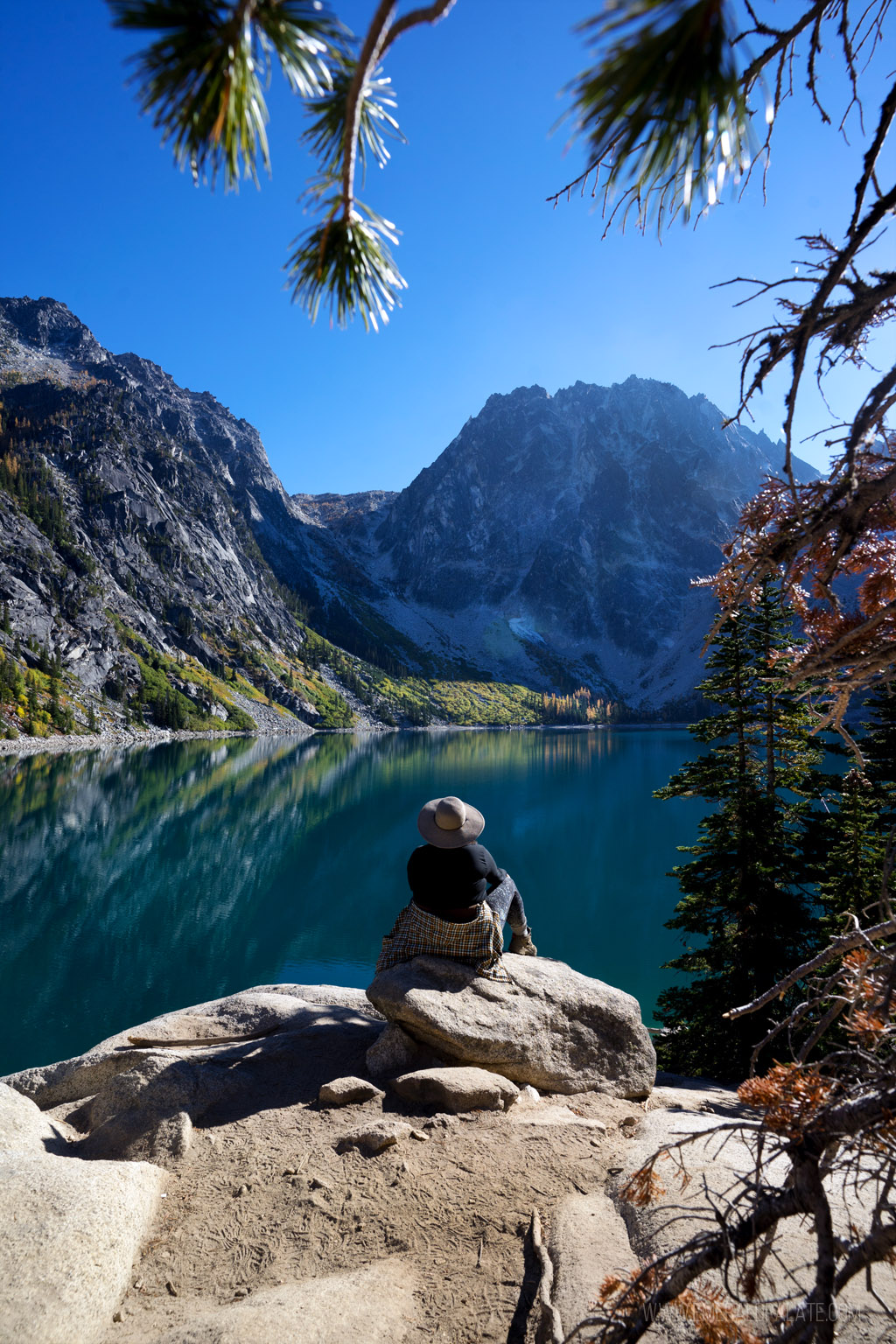
Lastly, all that up-and-down makes for “false summits” that trick you into thinking you’re at the top. It was like a haunted house with that hallway that never ends. This meant we didn’t eat lunch until way too late.
All in all, I thought Colchuck was way harder than WTA or reviews let on. While I wouldn’t call it impossible, it took us ~8 hrs when we’d estimated 6 (4-5 of that was getting to the summit). And unfortunately the larches weren’t ready yet, so the top was anticlimactic for us. I have a picture below of what it could have looked like with larches, though.
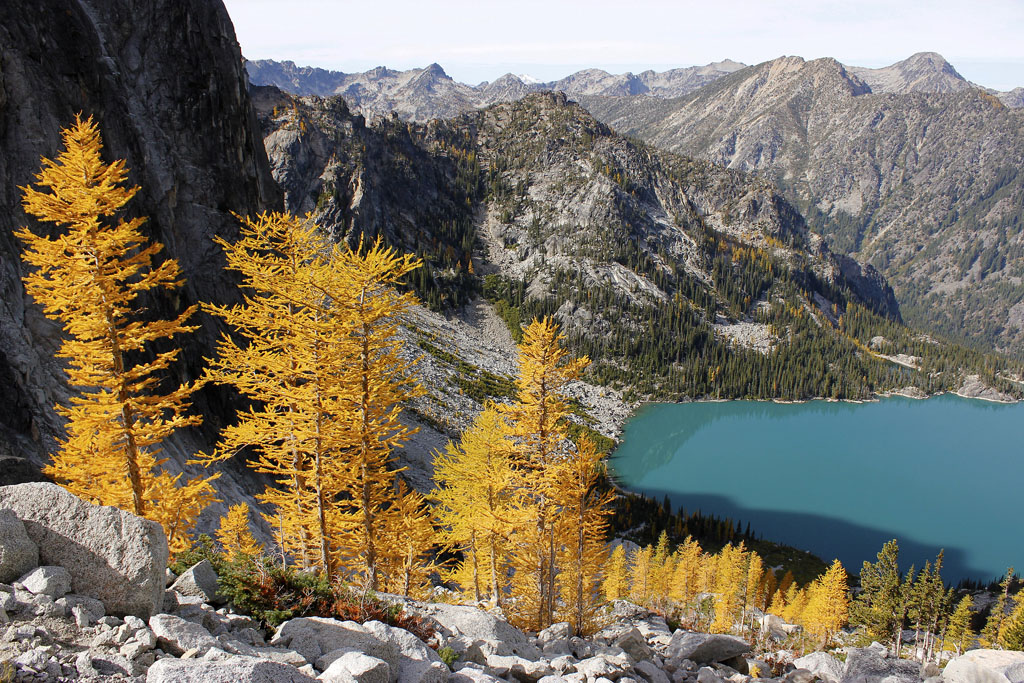
Photo via US Forest Service Pacific NW
Pro tip: Get to the Colchuck Lake trailhead before 8 am on a weekend to secure a spot in the lot. Otherwise you’ll need to park at the trailhead you passed to get here about 1 mile up the road. If possible, hike on a weekday to avoid parking woes.
Also, make sure to bring cash for the Forest Pass available for purchase at the trailhead. Rangers do check this area often, so you’ll likely get a ticket if you skip getting a pass. There’s no way to pay via card.
Lastly, the road getting here is a bit rough. We were fine in a Subaru sedan, but SUVs had a quicker time of it.

The Enchantments
Alltrails link | wta.org link | ~18 miles one way | difficult | Northwest Forest Pass and overnight required
The Enchantments are a 3-hour drive from Seattle and 30 minutes from Leavenworth. It’s made up of a series of trails that weave between what is called the lower and upper Enchantments. Colchuck Lake is one of these lake trails.
While you can day hike The Enchantments in about 7 miles, most people know it as an overnight backpacking experience. But the experience only comes for those who want it because you need to get a camping pass that’s awarded via lottery around February. This means getting that permit isn’t guaranteed, and getting it during larch season is even less guaranteed.
But it’s the photos of the golden larches at The Enchantments that first turned me onto larches. This is the dream larch hike. I’m not into overnight backpacking, but if I could get a permit for larch season I’d do it.
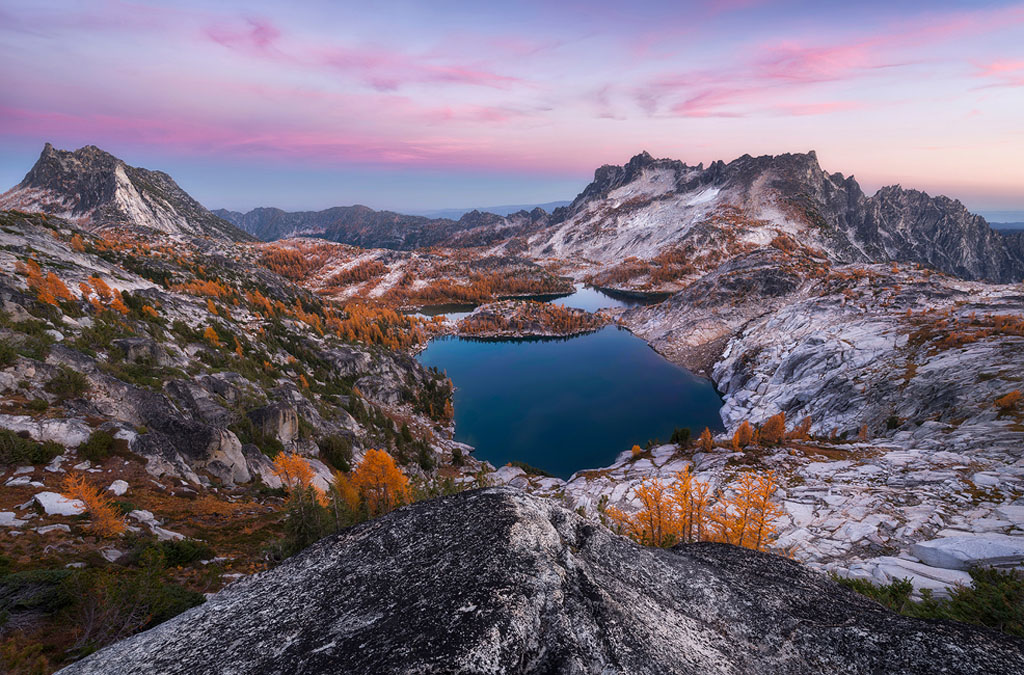
Photo via Paul Weeks
Clara and Marion Lakes
Alltrails link | wta.org link | ~3.2 miles | moderate | no pass required
Clara and Marion Lakes are a 3-hour, 20-minute drive from Seattle and about an hour from Leavenworth (it’s closer to Wenatchee). It’s accessible via the Mission Ridge Ski Resort parking lot, making it easy to get to year round.
I haven’t been on this hike yet, but am intrigued because it’s one of the shortest hikes I’ve discovered for seeing larches. Some trip reports say it’s difficult in some parts, but overall it looks like a pretty moderate hike.
Swauk Forest Discovery Trail
Alltrails link | wta.org link | ~2.45 miles | easy-moderate | Northwest Forest Pass required
This is another larch hike I’m interested in because it looks easy. This hike is said to be more of an interpretive trail popular among families with kids. It’s located in Blewett Pass, one of the few places in Washington where you can see larches while driving. I’ll update this article when I do this hike!
Minotaur Lake
Alltrails link | wta.org link | ~3.5 miles | difficult | no pass required
Minotaur Lake is in the Steven’s Pass area and a 2 hour, 15-minute drive from Seattle or hour from Leavenworth. This is another one of the shorter best larch hikes in Washington.
However, don’t let the length of the hike fool you: this isn’t easy. While it’s only 3.5 miles, it’s a straight shot up for the first mile-ish. It’s not the most difficult hike I’ve ever done, but I had to take several breaks to catch my breath and stretch my screaming calves. I couldn’t imagine doing this hike in the dead of summer given the exertion right away.
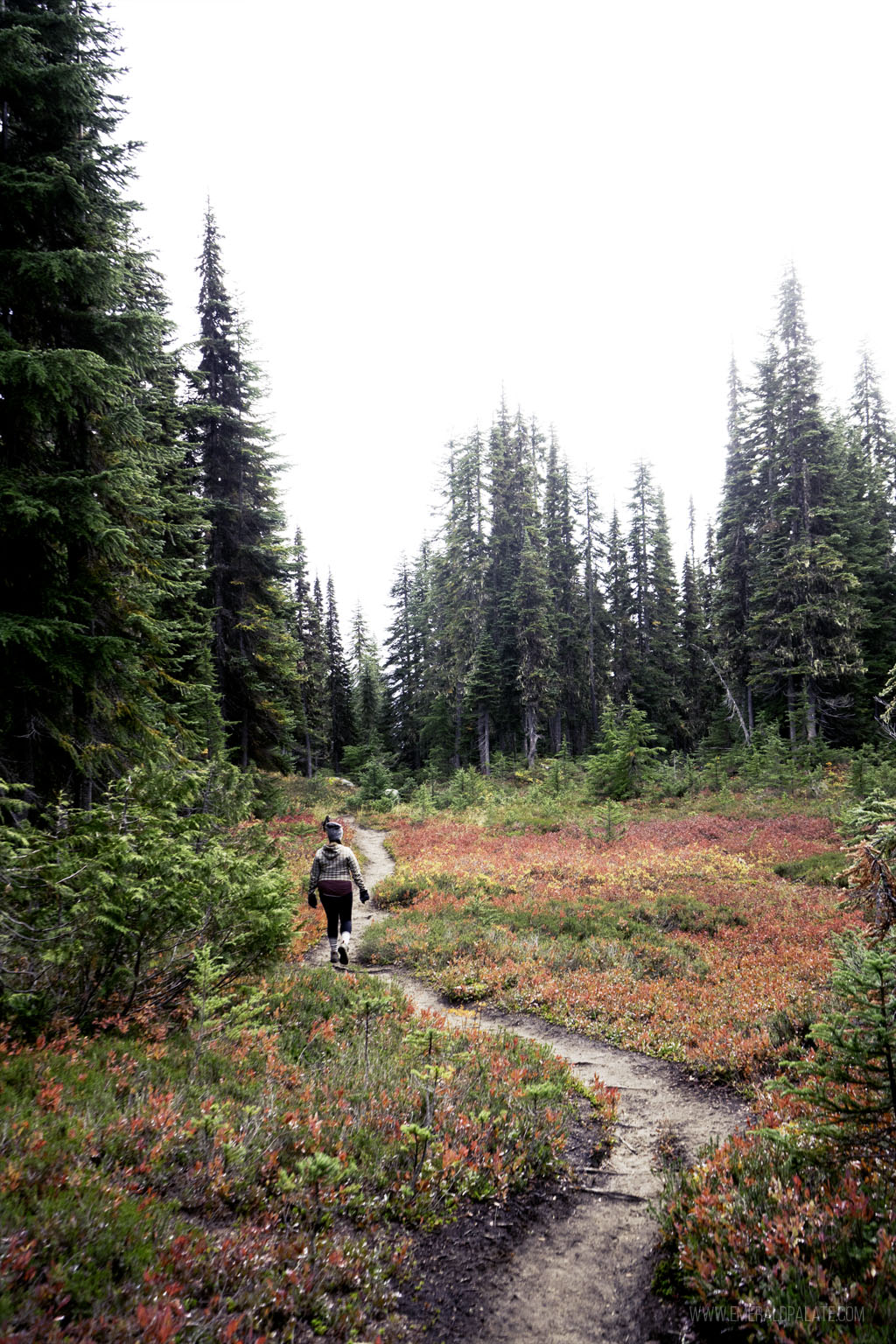
The top makes the pain worth it. After that first mile you come into a beautiful meadow. In the spring the meadow has wildflowers, but in the fall it’s a myriad of red, orange, and yellow fall foliage. After the meadow you come to Minotaur Lake, a beautiful hidey-hole on the side of a peak. It’s small, but exploring the area and perching on a rock for lunch is beautiful.
You can also continue up a very short trail that takes you to a cliff overlook Thesius Lake from above. When it’s clear you’ll see mountain peaks far in the distance behind the glistening blue lake. Don’t miss this part of the hike because it’s stunning.
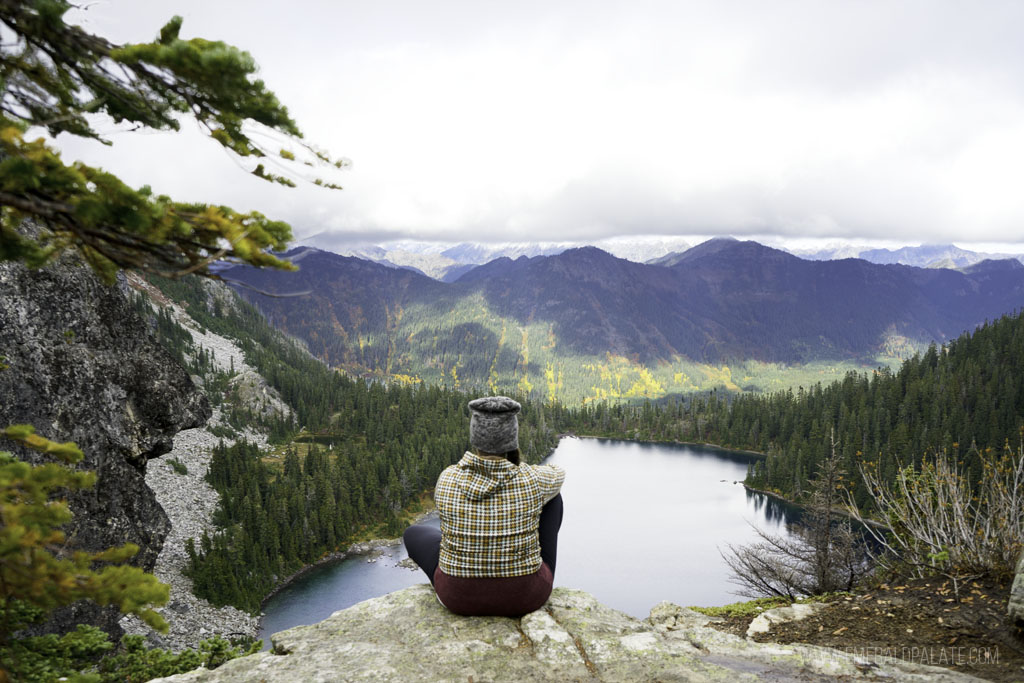
A few logistical things to note. First, there’s no toilets at the base so go beforehand. Second, Google messed up when we were driving there and didn’t say anything on the GPS about bearing left on the main road it takes you on to get to the hike. Since it didn’t speak up, we continued on what looked like the main road because it was large and paved. But we should have went left on the dirt road. Follow along on the GPS and make sure to bear left at the major fork you’ll encounter.
Lastly, this hike took us about 4.5 hours. I found the down part more exerting because I was using major muscles to stabilize myself going down. However, the way up was more cardiovascularly challenging. Consider bringing gloves if you take this larch hike in the fall so you can grab onto trees to support yourself without getting your hands dirty.
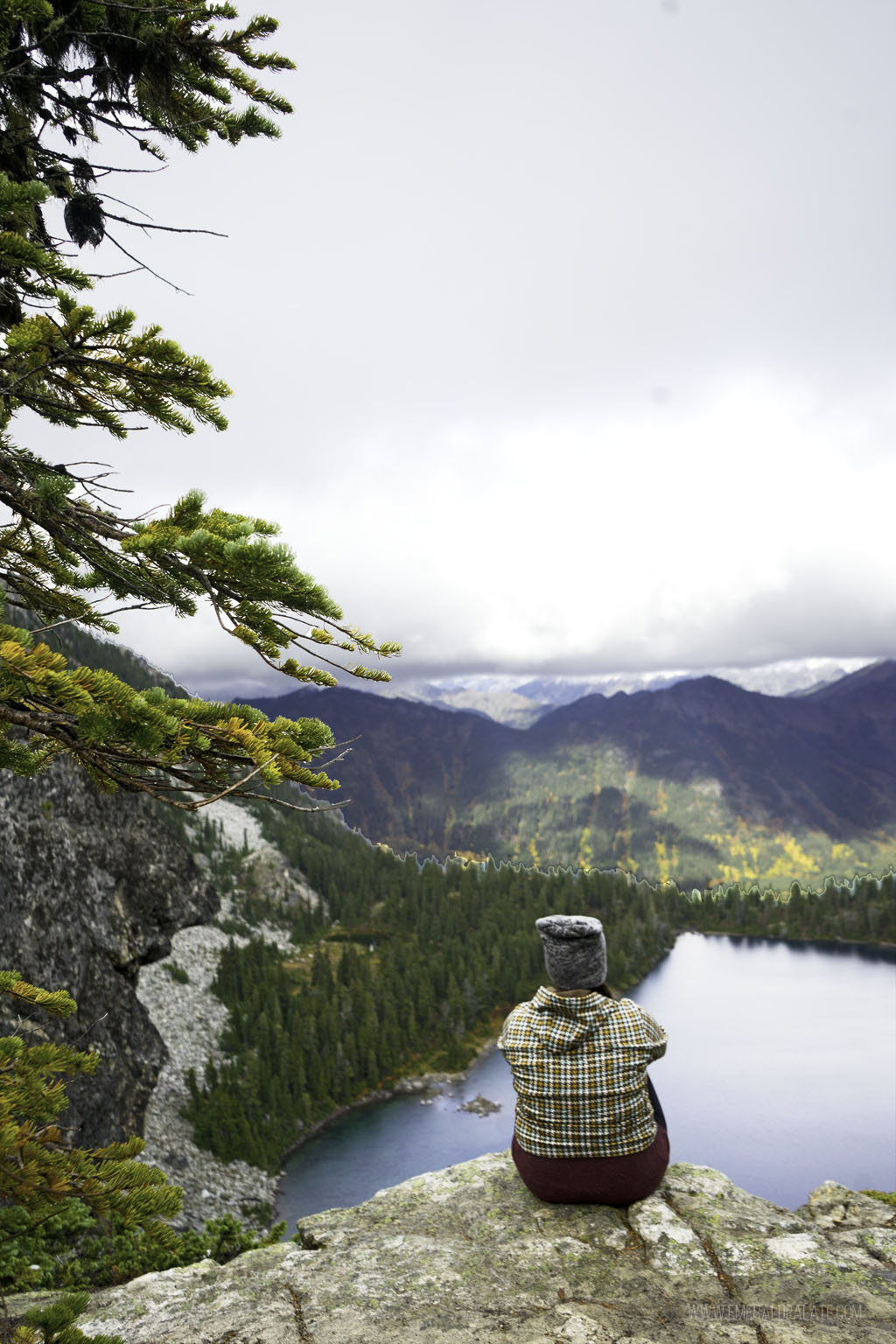
North Cascades-area larch hikes
The North Cascades region is, as its name suggest, in northern Washington closer to the Canadian border. Since this area is closer to eastern Washington than Western, it makes sense to stay overnight to do these best larch hikes in Washington. And since this area is Washington’s only free national park, you should carve out time to follow my North Cascades itinerary to see all the best attractions.
Winthrop is one of the closest towns near these hikes, which hosts a magical Winthrop hot air balloon festival each winter that I highly recommend you add to your bucket list. There are also a lot of great Winthrop, WA restaurants and things to do in Winthrop, such as doing some of the best cross-country skiing in Washington come winter.
But for now, we’re talking about autumn. Here are larch hikes in the area known for finding the best fall colors in Washington state.
Heather-Maple Pass Loop
Alltrails link | wta.org link | ~7.2 miles | moderate | Northwest Forest Pass required
The Heather-Maple Loop Pass is about a 3 hour, 20-minute drive from Seattle. It’s near Winthrop in the Methow Valley and located right in North Cascades National Park, one of the most underrated parks in the US.
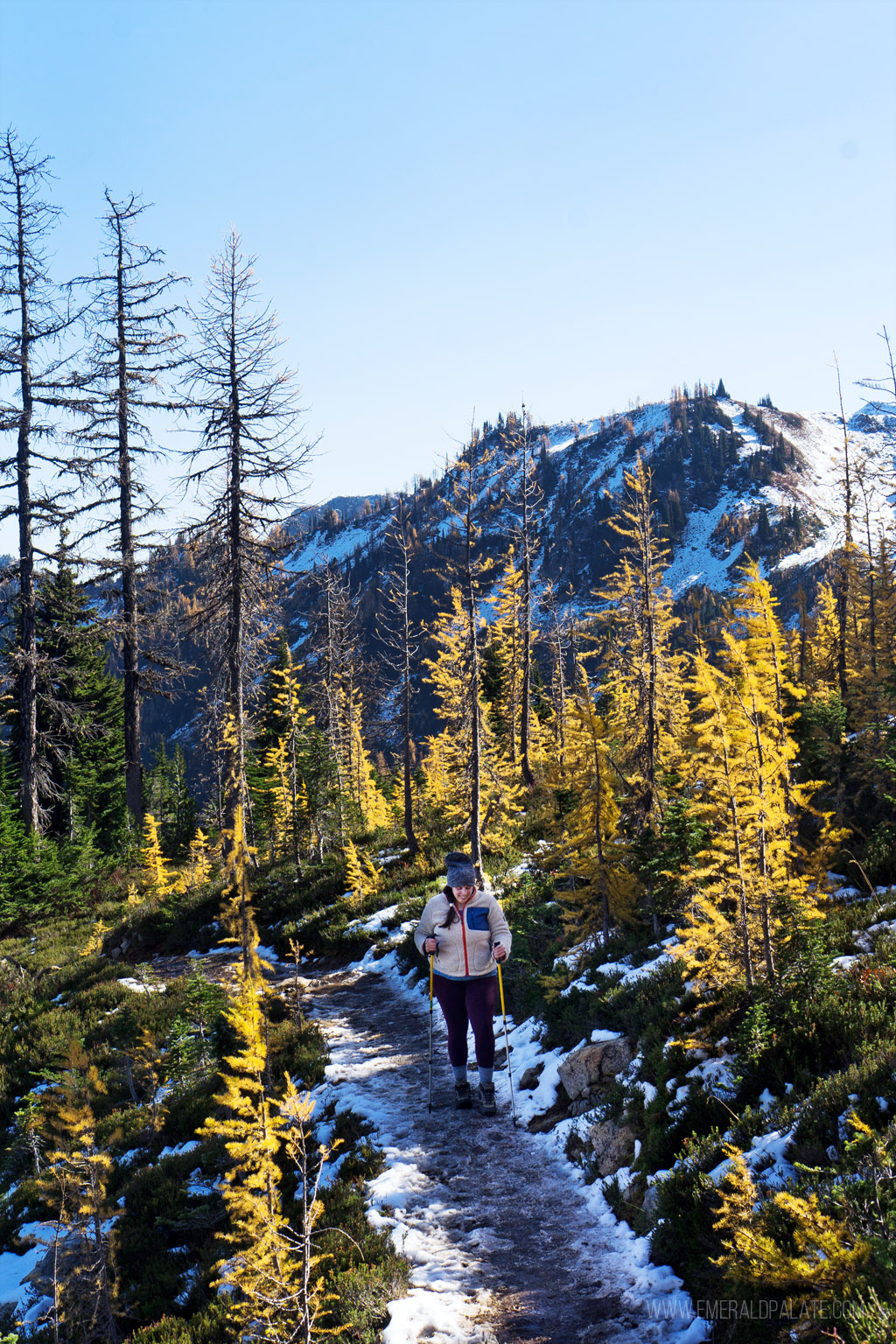
This is one of my favorite hikes in Washington, larches or no larches. If you go counter clockwise (right at the trailhead), it’s a fairly gradual climb that doesn’t feel too difficult. The steep part is in the clockwise direction, so going counter clockwise lets you do that part on the way down. Or you can turn around and go back the way you came after hitting the ridge to avoid that section.
The trail will start in the woods and then open out onto a small ridge with pretty fall colors and views of the Cascades in the distance. It’ll go back into the woods before coming to a fork that lets you take a short detour to Lake Ann (not to be confused with Lake Ann at Esmerelda Basin in Snoqualmie Pass). I recommend skipping this because you’re going to get epic views of Lake Ann from above later.
A bit further up you’ll see a sign and a small trail veering right toward Heather Pass. I recommend checking this out because it quickly opens up to a meadow that has a ton of young larches. This is also the way you’d go if you were continuing another mile to Green Lake, which has gorgeous blue-green water you can see in the distance from a bit farther up the main trail (pictured below). I haven’t done Green Lake, but saw some people going that way once.
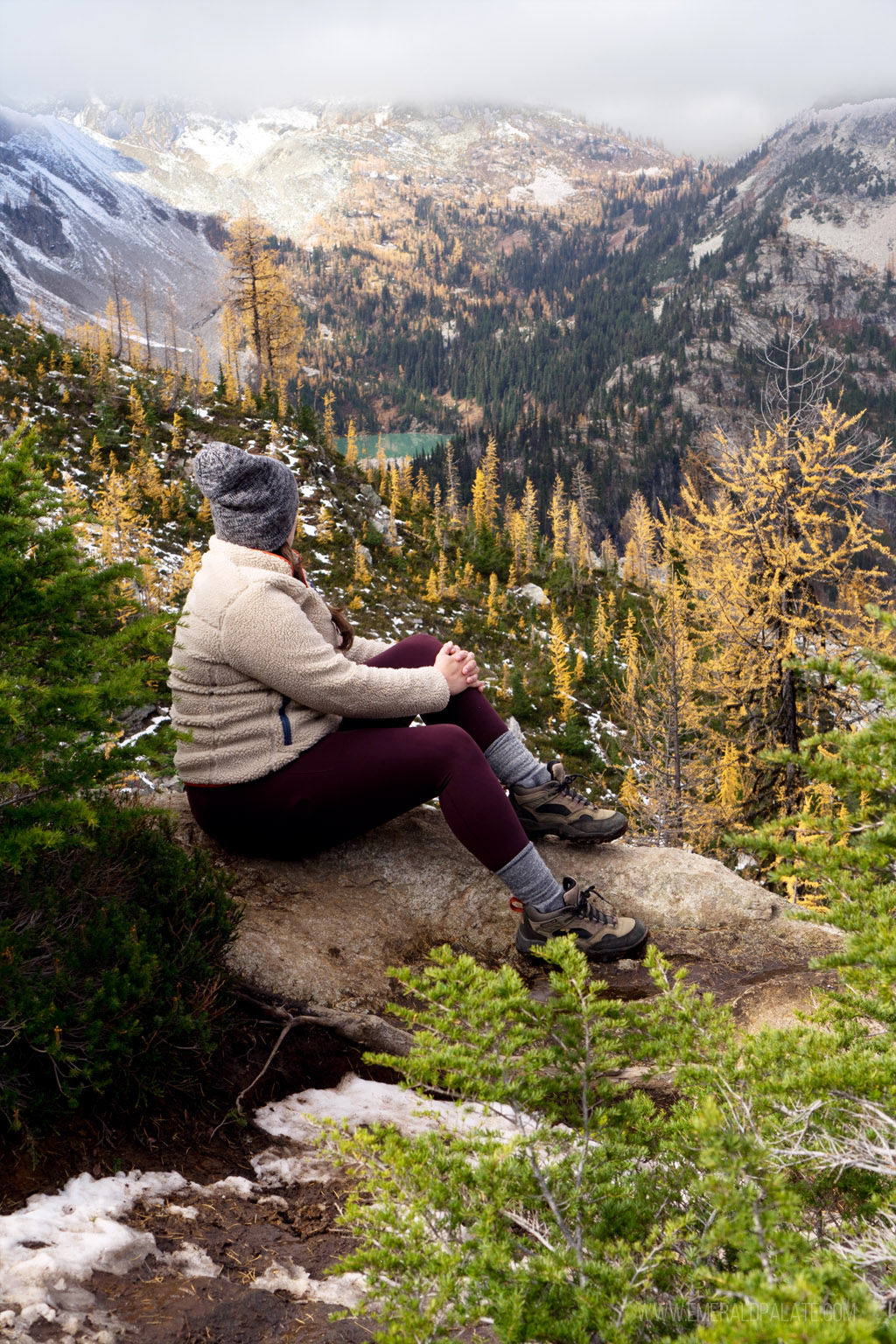
Before you get to the ridge at the highest elevation, you’ll come across another ridge with pretty views of Lake Ann from above and a ton of larches. You’ll also likely see snow depending on how late in the season it is. Read trip reports and consider bringing hiking spikes if trip reports say it’s icy.
Pro tip: The Wing Lake trail leaves from the same trailhead as Maple Pass. It has larches, but it’s more than 15 miles and considered challenging!
Cutthroat Lake
Alltrails link | wta.org link | ~3.8 miles | easy | Northwest Forest Pass required
Cutthroat Lake is a shorter, more family-friendly hike for seeing the golden larches. The trailhead is right across the street from the Rainy Lake Trailhead where you’ll leave for Heather-Maple Pass Loop.
Don’t confuse this hike with Cutthroat Pass (more on that below). This trail takes you to one side of the pass while the hike labeled Cutthroat Pass takes you from the other side. They do not start at the same trailhead.
The Cutthroat Lake trail is 1,900 feet lower than Cutthroat Pass, so it doesn’t offer as breathtaking of views, but it’s a great hike for larches if you want an easier option.
Cutthroat Pass
Alltrails link | wta.org link | ~10 miles | moderate | Northwest Forest Pass required
Cutthroat Pass is about a 3 hour, 15-minute drive from Seattle. It’s along the Pacific Crest Trail, so you may see backpackers passing through. I haven’t been on this hike yet, but all the pictures show its a perfect larch hike.
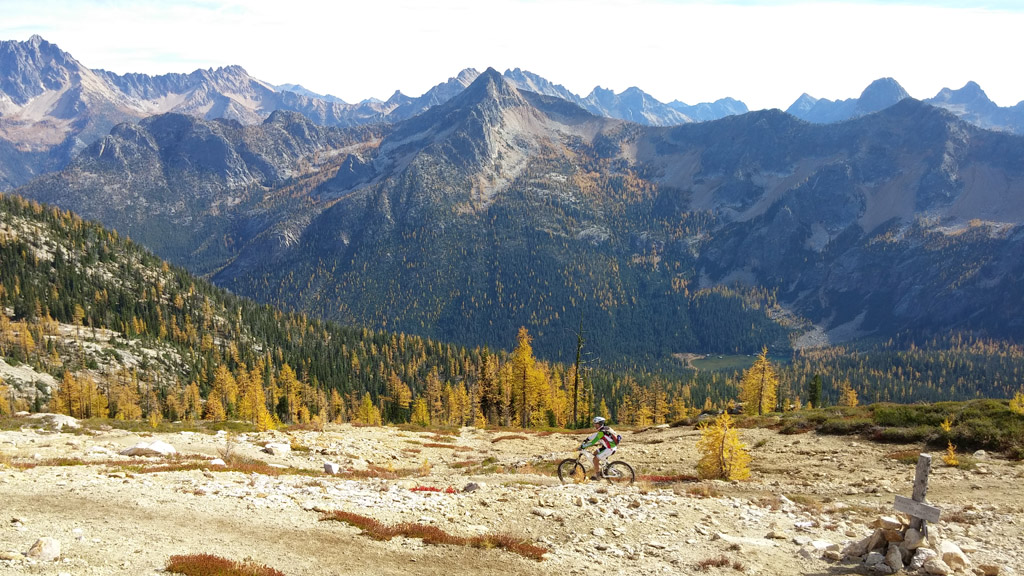
Beware of thefts that have been reported at the parking area. It also sounds like you’ll need to cross more than 10 creeks to complete this hike, though most hikers report it’s easy enough with rocks. However, check the trip reports because sometime higher water elevation can make it impossible to cross without getting wet.
Easy Pass
Alltrails link | wta.org link | ~7 miles | moderate/difficult | Northwest Forest Pass required
Easy Pass is about a 3-hour drive from Seattle. It’s name may make it sound like a breeze, but I read it’s quite difficult. I haven’t been on this larch hike yet, but I read you should continue past the pass toward Fisher Creek for spectacular meadow views.
Blue Lake
Alltrails link | wta.org link | ~4.4 miles | easy-moderate | Northwest Forest Pass required
Blue Lake is about a 3 hour, 15-minute drive from Seattle. It’s one of the shortest and easiest of the best larch hikes in Washington you’ll find on this list, which also means you can expect to see a lot of people on it if it’s the weekend.

The trail starts with some boardwalks running parallel to the highway, but then it veers to the right and start going into the woods. You’ll be let out into a gorgeous meadow with a huge mountain looming ahead. You may think you need to climb that, but the path will veer left and take you through the woods.
I’d rate this as an easy-moderate hike. I did it after hiking the day before and was sore, so I felt a bit more winded than I think I would have otherwise. There isn’t really ever a big steep part, but it does have a consistent climb.
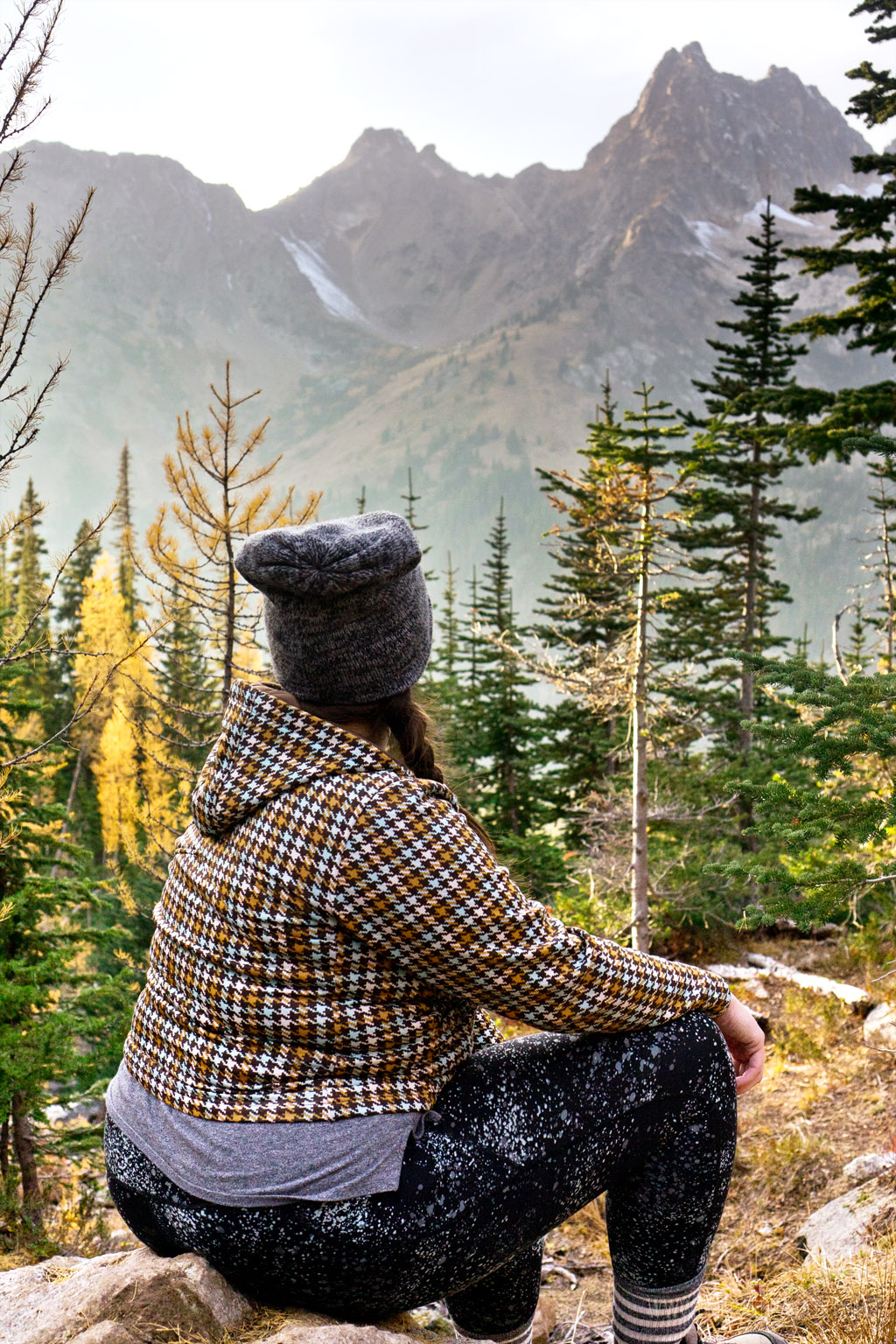
Before you get to the summit there will be another ridge with absolutely breathtaking views of the Cascade Mountains. You’ll start seeing larches here, but keep going after a few photos to the lake itself.
It’s the lake where, if you come during peak larch time, you’ll see crystal clear waters surrounded by golden larches. I came a bit late in the season and unfortunately the larches around the lake were womp womp. However, the ones leading up to it were stunning!
If you have time, stop at the Washington Pass Overlook less than a mile away from the trailhead. It offers a stunning viewpoint of the Liberty Mountains from the side opposite Blue Lake. You’ll often see larches dotting the mountainside.
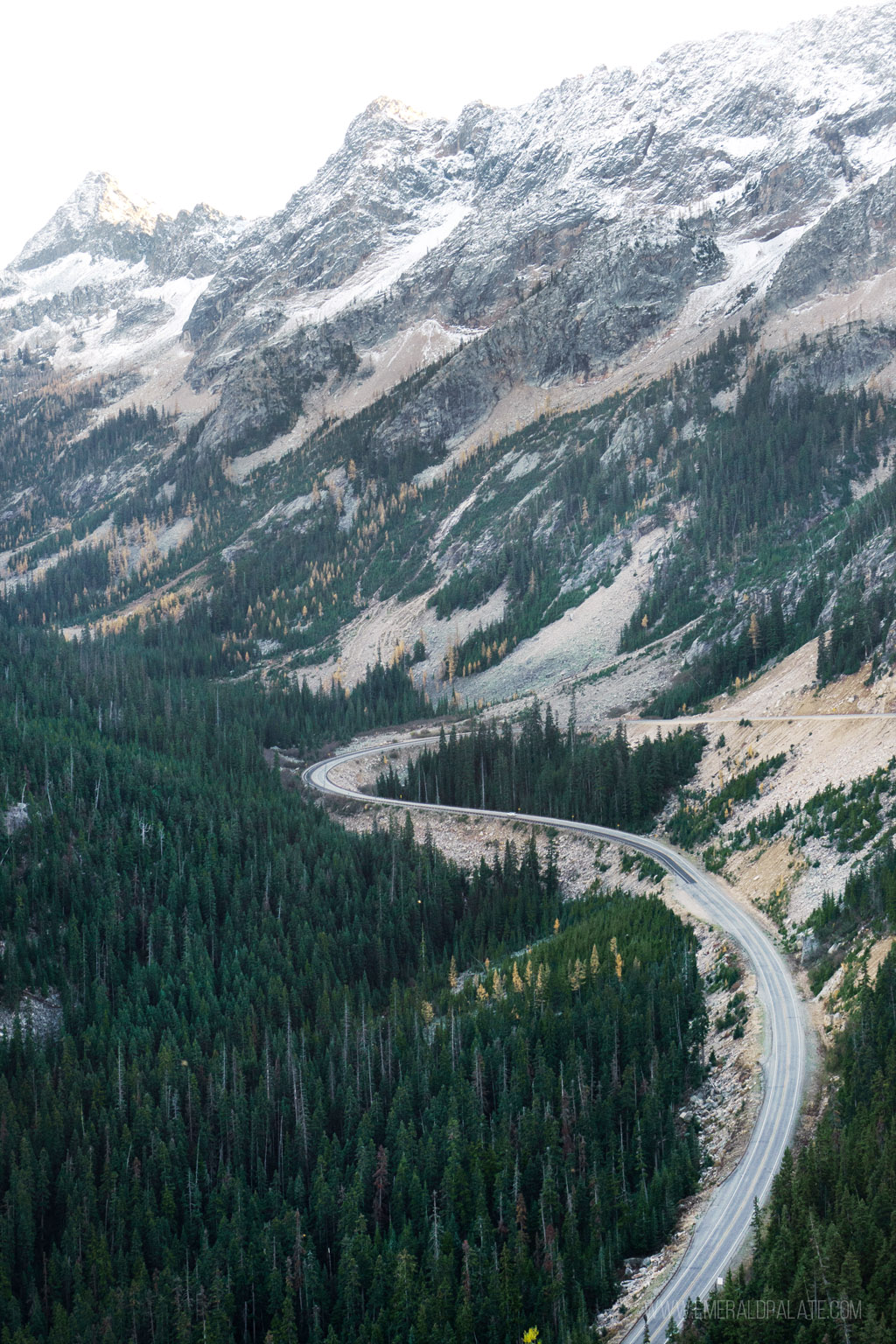
Eagles Lake
Alltrails link | wta.org link | ~12.5 miles | moderate | Northwest Forest Pass required
Eagles Lake is about 4.5 hours away from Seattle. It is a moderate hike, but could be considered difficult given its length. The trail has a gradual, but persistent uphill climb there and the path is shared with bikers and horseback riders.
Despite the length, this looks like one hell of a larch hike. Their golden needles dot the slopes leading to a bright blue lake. This is toward the top of my list of hikes for larches I hope to take soon!
Goat Peak Lookout
Alltrails link | wta.org link | ~3.7 miles | moderate | Northwest Forest Pass required
This is another shorter larch hike near Winthrop. I’m intrigued because I hear there’s a big payoff for relatively little effort. I haven’t done this hike yet, but I read it has only a few mercifully-short steep inclines. There’s also a fire lookout to add some visual interest to your photos!
Cooney Lake
wta.org link | ~17.6 miles | moderate | Northwest Forest Pass required
This is another long larch hike. The Cooney Lake trailhead is about 4.5 hours away from Seattle and weaves through hundreds of larch trees on the way to the lake. There are a lot of campgrounds in the area and, given its length, may be something you want to consider.
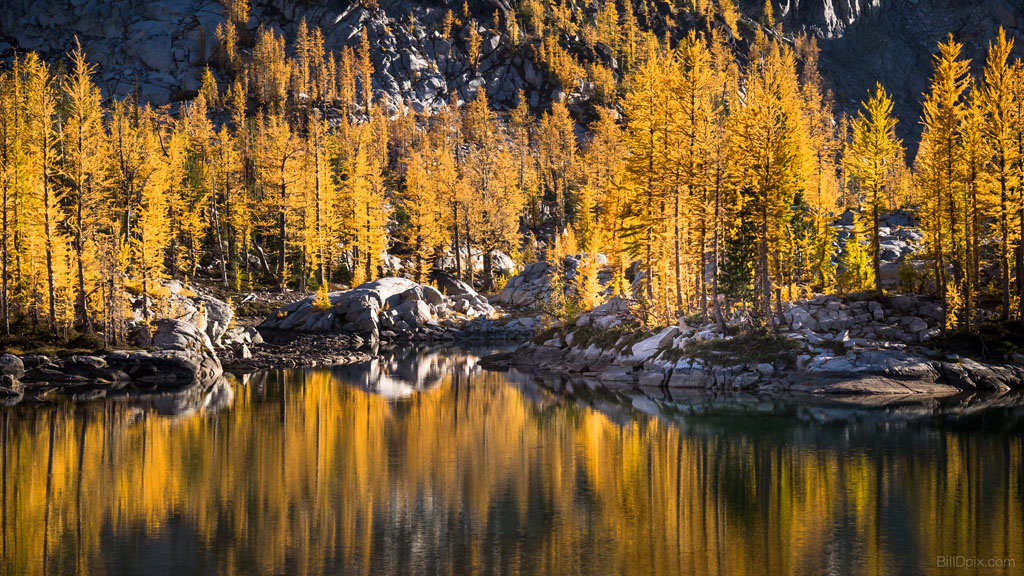
Photo via Bill Devlin
Eastern Washington larch hikes
The majority of best larch hikes in Washington are found in the middle of the state, but I read about one eastern Washington one!
Sherman Peak Loop
Alltrails link | wta.org link | ~5.9 miles | moderate-difficult | Northwest Forest Pass required
I haven’t done this larch hike in Washington yet, but I read this hike has a gradual ascent without too many difficult sections. It doesn’t take you to Sherman Peak, but rather around it. Pictures look as if you get quite expansive views of evergreen and larch trees dotting the mountains, so I’m interested in doing this hike in the future!
More to explore after hiking for larches
And there you have it, my full list of the best larch hikes in Washington for seeing the beautiful fall foliage in Washington state! If you’re making your larch adventure a weekend getaway, here are other ideas for what to do between hikes:
- Hunt for Larches in Banff National Park
- Best Fall Foliage in Seattle
- Why You Should Visit Wenatchee
- Best Lake Chelan Wineries
- Must-Try Restaurants in Lake Chelan
- How to Spend the Perfect Day at Mt. Rainier
- Things to Do During Fall in Seattle
